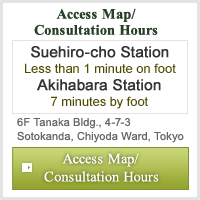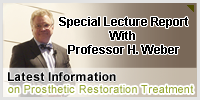2009年4月17日 « トップへ » 2009年4月19日
2009年4月18日
Locking partial dentures [Riegel telescope]
Riegel is German for 'bolt' (as in a deadbolt). Riegel telescope dentures use a bolt-like locking mechanism as retention equipment.

There is a small lock on the inside of the dentures. When the lock is shut, it is nearly unnoticeable to the tongue. Dentures can be removed easily by simply opening the lock (it is opened easily by hand).
As opposed to Konus telescope, which are retained in the mouth by the wedging power of inner and outer crowns, Riegel telescope does not exert any force on existing crowns. Also, these dentures are well-suited for teeth that are missing nerves.
Comfort that will have you forgetting that you are wearing dentures
For the most part, our dentures are so comfortable that you will forget that you are even wearing them. You can brush your teeth before you go to bed, wash your dentures, and go to bed with them still in (there is no need to worry about swallowing them while you sleep).
Only your pearly whites are visible when you smile
Where Konus telescope inner crowns are scattered about, Riegel telescope inner crowns are linked and fixed together in place. The locking mechanism is placed where no one can see it making these dentures more esthetically pleasing than those covered by health insurance. When you smile, the only thing that people will be able to see are your beautiful pearly whites!
There are many types of telescope systems in Germany, but in Japan, Konus telescope is the only one that was known.
Some types of telescope system treatment methods are Parallel telescope, Konus telescope, Riegel telescope, and Resilience telescope. Certain types are best suited to treat certain cases.
Riegel telescope is one of these methods. The first time that our advisor, Dr. Inaba, saw Riegel telescope was during his stay at Tubingen University as a visiting professor in 1978. It was a telescope method that he had not yet seen during his clinical experience.
He was determined to learn this new method in Germany and was able to treat his first patients there. While under the instruction of Professor Koerber at Tubingen University, he was able to learn the manufacturing process by observing in detail the superior work of the Master Dental Technician, Schiever.
At first glance, Dr. Inaba thought that Riegel telescope resembled a retention device that could be used as a type of detachable bridge, but he had no idea how it was made. So Dr. Inaba was allowed to carry out clinical care on patents while learning the manufacturing process from the Master. At first he had no idea how the manufacturing process worked, but he began to understand gradually as if a magic trick was being revealed to him.
He learned that Professor Strack from Tubingen University was the brainchild of Riegel telescope, and that the first people to actually make these dentures were Master Oigen Shraihi, and Professor Koerber.
Revolving Riegel (Dreh Riegel) and Swing Riegel (Schwenk Riegel) are two kinds of Riegel telescope. The manufacturing process of Revolving Riegel is quite difficult and so it is not used so often these days. Riegel lever equipment features a nook that is very narrow which makes it very convenient to use.
The 'main feature' of Riegel telescope is that retention is not dependent on inner and outer crowns, which means that they are much easier to remove. Also, retention force fixes inner and outer crowns in place through the Riegel lever (the bolt). Once the lever is released there is no resistance, making attachment and detachment easy. The 'secondary feature' of Riegel telescope is that since the device is primarily fixed into place, abutment teeth are also fixed into place. With abutment teeth fixed into place, the dentures can be used as a long-term prosthetic. Dr. Inaba has seen a number of patients who have been using the same set of dentures for more than 30 years.
In recent years this method has even been used in the upper structure of implants. The technology is becoming more compatible with CAD/CAM and these dentures are becoming more adaptable as removable upper structures.
Konus telescope
Konus means 'cylindrical' in German and dentures made through this method consist of inner crowns that attach directly to the teeth, the denture body, and outer crowns (a dual crown system).
The inner crowns are cylindrical and have a 6 degree angle (the Konus angle). Retentive force is provided by the wedging force created between the inner and outer crowns. It may be easier to understand if you can imagine two cups of the same shape stacked over each other. The dentures make a snapping sound when they are shut and they will not come off.
There is a notch in the dentures where the patient places their finger and lifts to remove them. The angle of the crowns can be adjusted to fit the condition of the teeth.
Konus telescope dentures are not suitable for teeth that lack nerves. There may also be contraindication in places where teeth remain.
Differences between health insurance-covered dentures and dentures made using the maxillomandibular simultaneous impression method
Full dentures made within the scope of health care services provided by health insurance and those paid for out of pocket made using maxillomandibular simultaneous impression method are vastly different.
Of course, dentures covered by insurance will not be perfect as they are limited by materials and amount of time and attention to detail they can spend on each set. Following is an explanation of some of the differences between health insurance-covered dentures and dentures made using the maxillomandibular simultaneous impression method.
Conventional dentures: Demerits of taking the upper and lower jaw molds separately
1. Since the patient opens their mouth and has the upper and lower tooth mold taken separately, errors can occur in placing the mold device in the mouth. As a result of this, the patient must make extra visits to the clinic (anywhere from 6 - 10 times).
2. This method is incapable of recording data concerning the movement of muscles around the mouth, the tongue, and the lips while functioning.
3. It is also incapable of simulating the state of the mouth while eating by measuring movements when the patient swallows saliva.
4. The pressure used to make the mold varies for the upper and lower jaw.
5. The natural pressure of the mouth is different from that used to make the mold since the dentist decides what pressure to use when taking the mold.
6. The natural bite pressure is different from that used to make the mold since the dentist takes the mold manually.
Dentures from our clinic: Merits of using the maxillomandibular simultaneous impression method
1. Since we take precision molds, record bite alignment data, the height of the upper and lower jaw, and tooth position all at once, there is no need to come back for mold taking over and over again like with conventional dentures. *The process is complete in just 3 visits.
2. We make the mold while recording the bite alignment height which achieves an ideal balance.
3. We have you swallow saliva while taking the mold so that we can record the movements of your mouth.
4. We place the model made from your mold as it is into the actuator thus reducing the chance of error.
5. We record information about your mouth muscles, tongue, and lips under natural pressure exerted by you and not the dentist.
6. We can place artificial teeth in well-balanced positioning suited to your mouth.
7. Conventional dentures are prone to fall out with tongue movements since their gum shape was made to extend to reach deep back around the tongue. But with dentures made using the maxillomandibular simultaneous impression method, the area in front of the tongue is used effectively. This makes it easy to swallow saliva and pronounce words.
8. The method used to produce the denture gums, called Ivocup System (polymerization) is a precise polymerization technique completely different from that used in the production of insurance-covered dentures. This allows us to take advantage of the water-film phenomenon (the same phenomenon as when two panes of glass are stacked with a film of water between them making them difficult to separate), which achieves a secure retention.
9. Cases where the patient suffers from extremely thin bone were considered advanced cases up until now. But with this new system, it can be expected that the retention provided by the muscles around the mouth, the lips, and the tongue will be sufficient so that there is little effect on the bones. We have seen very positive results with our treatment method in these cases.
10. By using German KaVo Corporation actuators, cooperation between dentists and technicians is strengthened.
*actuator = bite alignment device
Resilience telescope
Resilience telescope dentures are suitable for cases in which the patient has 4 teeth or less remaining (on either jaw).
There is no burden on your remaining teeth
The retention force of Resilience telescope dentures is not dependent on the teeth, but rather the membrane of the mouth. This means that there is practically no burden placed on remaining teeth.
Inner and outer crowns of Resilience telescope dentures are made leaving a 200-micron wide gap to facilitate membrane subduction. These dentures allow the patients' remaining teeth to last as long as possible.
A merit of these dentures is that if the patient happens to lose a tooth, they can be adjusted easily. This means that they last a very long time. Clasp dentures put an added burden on remaining teeth and when one falls out, they need to be remade from scratch. This can be a mentally exhausting and time wasting experience for patients.
No need to remove them at night
Of course patients are always happy to hear that these dentures do not need to be removed at night. German dentists advise patients to sleep with their dentures in at night. Our own patients who use these false teeth have said of them, "I feel like they have become such a part of me that I feel uneasy about taking them out."
I often hear stories of people who left their dentures behind after the Hanshin Earthquake and suffered unnecessarily, not being able to eat properly in the aftermath. Another reason to sleep with these dentures in is that they help you breathe through your nose, which keeps the inside of your mouth moist and makes breathing easier.
Compared to implants
It can cost from 3,000,000 to 5,000,000 yen to have all of your bottom teeth replaced with implants. It also does a number on your bones. Wouldn't it be better to preserve your remaining teeth by choosing Resilience telescope?
I personally believe that patients with few remaining teeth are much better off choosing Resilience telescope, which is esthetically and hygienically superior to implants.
Patients have been very pleased with the esthetic superiority of these dentures, since tooth alignment can be constructed to fit their ideals.
The other day we had a young female patient whose countenance was completely transformed thanks to these dentures. She became quite the beauty! Her before and after shots look like two different people.
<Hear from our patients>
A 59 year old man who was treated with Resilience telescope
I regret not asking about them earlier.
2009年4月17日 « トップへ » 2009年4月19日









